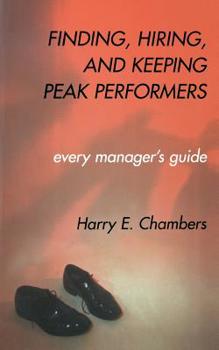Finding, Hiring, and Keeping Peak Performers
Select Format
Select Condition 
Book Overview
Every manager or business owner knows that the most precious and scarce commodity is talent. And it's a seller's market-with scrappy dot.com start-ups vying with traditional corporations for the best... This description may be from another edition of this product.
Format:Paperback
Language:English
ISBN:0738202894
ISBN13:9780738202891
Release Date:May 2001
Publisher:Basic Books
Length:336 Pages
Weight:0.90 lbs.
Dimensions:0.7" x 5.5" x 8.2"
Customer Reviews
3 ratings
Good food for thought
Published by Thriftbooks.com User , 20 years ago
When you have no one reporting to you, your job is largely determined by your supervisor. However, when you are a manager, the people who work for you can either ensure your success or make it virtually impossible. This book gives you a lot to think about in terms of how to systematically identify, recruit, and retain the best performers- those people who will make you look best. While I don't agree with all the specifics, the areas discussed are vital to consider. The book is also well written.The only real downside to this book is that it assumed the employees' market of 1999-2000 would last forever. While that's not true, and companies may accidentally, in employer's markets, be able to get good employees, the best employees will flee to companies that treat them right when the market turns.
A MUST-READ BOOK FOR EVERY EMPLOYER!
Published by Thriftbooks.com User , 23 years ago
With over thirty years in business management, I have found one philosophy that works: Always hire a winning player from a winning team - they have learned how to succeed. If you hire a player from a losing team, they have learned how to justify failure.This book is filled with helpful information on hiring the right employee in the first place, and we all know that with so many wrongful dismissal suits emerging today, that it can be difficult to terminate an employee if you discover, after the fact, you have hired the wrong person. The author also points out where to find top-notch employees and equally as important, how to maintain them. If you have an A1 employee, you have a gold mine! Treat employees with dignity, respect, honesty and appreciation; motivate employees, give them responsibilities, freedom to do the job, just and fair rewards and they will help your company to achieve maximum profits. Next to your customers, your employees are the backbone of your business. They can contribute to your company's success or failure, the choice is yours. This is an excellent book for a small price and certainly worth reading - a five star plus!
A Never-Ending Process
Published by Thriftbooks.com User , 23 years ago
I cannot think of a greater challenge to organizations today than to find, hire, and then keep peak performers. This is one of two books which I have just read which suggest excellent strategies and tactics to meet this challenge. (The other is The Employee Recruitment and Retention Handbook, authored by Diane Arthur.) But what if an organization now has few -- if -- any peak performers? Obviously, it must develop them. How? In Hidden Value, O'Reilly and Pfeffer explain how great companies achieve extraordinary results with ordinary people. You can also hire peak performers. (They think in terms of investment and ROI rather than of cost. So must you.) In my opinion, an opinion with which Chambers may agree, organizations must be constantly, indeed aggressively involved in recruiting all the time. That is to say, at least decision-makers must be identifying "the best and the brightest" workers employed elsewhere. Perhaps there is no need for them now. Even so, it is important to know who they are, to establish contact with them, and then stay in touch. Chambers suggests a number of effective strategies and tactics to do so. He organizes his material within three predictable Parts: Finding Peak Performers, Hiring Peak Performers, and Keeping Peak Performers. In this volume, he could have added a fourth Part: Recapturing Peak Performers. (He has already addressed many of the key employee-recapture issues in two previously published works, The Bad Attitude Survival Guide: Essential Tools for Managers and No Fear Management: Rebuilding Trust, Performance and Commitment in the New American Workplace.) What I find especially interesting about Chambers' observations and recommendations is that they are equally relevant to finding, obtaining, keeping, and (yes) recapturing customers. His recommendations are based on essentially the same principles although, obviously, strategies and tactics appropriate to employees will be different from those appropriate to customers. In any event, Chambers seems to have covered all of the proverbial "bases" such "Developing Real-World Needs Assessments" (Chapter 2 in Part I), Aligning the Interview and the Needs Assessment (Chapter 7 in Part II), and "Creating the Culture of Retention" (Chapter 10 in Part II). The final chapter summarizes key points. The material seems to be based on a wealth of real-world experience. As Chambers explains, "This book was written to provide you, the frontline manager, with the real-world tools you need to increase your ability to find, hire, and keep peak-performing employees. You will not find a lot of theory or academically driven processes to program your behavior. You will find experience-based skills and strategies to help you find and keep the people who will have a positive impact on your productivity and, frankly, increase your value as a manager." I include this last portion of the explanation because so many other books on this same general subject (many of them first-rate) se






